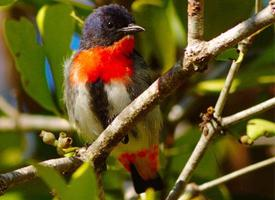
Greutăți și măsuri
| Lungime | de la 9 la 10 cm |
|---|
Descrierea animalului
The Mistletoebird (Dicaeum hirundinaceum), also known as the Mistletoe Flowerpecker, is a small, captivating passerine bird that is native to Australia, and can also be found in the eastern Maluku Islands, and New Guinea. It is the only member of the Dicaeidae family found on the Australian mainland, with a striking appearance and a specialized diet that makes it an important ecological agent for the propagation of mistletoe plants, from which it derives its name.Adult Mistletoebirds typically measure about 10 centimeters in length, making them quite diminutive. They possess a compact, robust body with a short neck and a relatively large head for their size. Their bill is short, stout, and slightly curved, perfectly adapted for their diet consisting mainly of berries, especially those of various mistletoe species. The male Mistletoebird is particularly vibrant, with a glossy blue-black head, throat, and upperparts that contrast starkly with his bright red chest and undertail coverts. His belly is white, creating a striking three-colored pattern that is easily identifiable. Females, on the other hand, are more subdued in coloration, with grey-brown upperparts and paler grey or whitish underparts, often with a hint of orange on the belly and undertail coverts.
The Mistletoebird has a distinctive undulating flight pattern, characterized by rapid wing beats interspersed with brief gliding periods when the wings are tucked close to the body. This flight style is quite energy-efficient and allows the bird to move quickly between mistletoe clumps and other fruiting plants.
One of the most fascinating aspects of the Mistletoebird is its symbiotic relationship with mistletoe plants. The bird feeds on the berries of the mistletoe, digesting the pulp and excreting the sticky seeds either in flight or while perched. This excretion method facilitates the propagation of the mistletoe, as the seeds stick to the branches of suitable host trees where they can germinate and grow, continuing the cycle.
The bird's breeding season is closely tied to the fruiting of the mistletoe. Mistletoebirds are known for their elaborate nests, which are constructed by the female using cobwebs, plant down, and other fine materials to create a small, purse-like structure that hangs from a branch. Inside this secure and camouflaged nest, the female lays two to four small, white eggs that are incubated for about two weeks before hatching.
Mistletoebirds are known to be quite vocal, particularly during the breeding season, with a range of high-pitched, melodious calls and songs that can be heard throughout their habitat. These sounds play a crucial role in territory defense and in the courtship rituals between males and females.
Overall, the Mistletoebird is not only a bird of remarkable beauty but also one of ecological significance. Its role in the dispersal of mistletoe seeds makes it a keystone species within its environment, contributing to the biodiversity and health of Australian woodlands and forests where it resides. Despite its small size, the Mistletoebird is a prime example of the complex interdependencies that exist within natural ecosystems.
Fotografii noi cu animale
Top 10 animale
- Diana monkey (Cercopithecus diana)
- Dolphin gull (Leucophaeus scoresbii)
- Galápagos tortoise (Geochelone nigra complex)
- Moustached guenon (Cercopithecus cephus)
- Japanese spider crab (Macrocheira kaempferi)
- Colossal squid (Mesonychoteuthis hamiltoni)
- Fox tapeworm (Echinococcus multilocularis)
- Stone loach (Barbatula barbatula)
- Japanese macaque (Macaca fuscata)
- Barbary macaque (Macaca sylvanus)